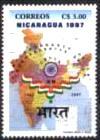

*Postage stamps depicted are from my personal collection*
|
India never invaded any country in her last 10,000 years of history. Mahatma Gandhi and Mother Teresa, the Saint of Calcutta as she was called, are considered the greatest apostles of peace of the twentieth century. |
 |
The concept of the number zero was created in India by the sage Aryabhatta. The place value system and the decimal system were also developed in India in about 100 B.C. |
|
Aryabhatta satellite of India |
The world's first University was established in Takshashila in about 700 B.C. More than 10,500 students from all over the world studied more than 60 subjects. The University of Nalanda built in the 4th century C.E. was one of the great achievements of ancient India in the field of education. |
|
Sanskrit is the mother lode of all the Indo-European languages. Sanskrit is the most suitable language for computer software, says a report in Forbes magazine, July 1987. |
Ayurveda is the earliest school of medicine known to mankind. Charaka, the father of medicine, consolidated Ayurveda 2500 years ago. |
India was the richest country on earth until after the coming of the British in the17th century. Christopher Columbus was attracted by her wealth. British, French, Portuguese, Dutch, Danish, and other "adventurers" were racing against each other to establish trading privileges in India. It was known as the true land of milk and honey. |
|
Vasco da Gama, discoverer of the sea route to India in 1498 |
The art of navigation was developed on the river Sindh 6,000 years
ago. The very word navigation is derived from the Sanskrit word "nav gatih". The
word "navy" is also derived from Sanskrit "nou". |
In the 5th century C.E. Bhaskaracharya calculated the time taken by
the earth to orbit the sun, hundreds of years before the astronomer Smart. Time taken by
earth to orbit the sun then was computed as 365.258756484 days. |
The
value of pi was calculated first by Budhayana, and he explained the wider ramifications of
what is known as the Theorem of Pythagoras. He discovered this in the 6th century, long
before the Arab and European mathematicians. |
Algebra, Trigonometry, and the basic concept of Calculus came from
India. Quadratic equations were propounded by Sridharacharya in the 11th century. The
largest number the Greeks and the Romans used was 106
whereas Hindus used numbers as large as 1053 with
specific assigned names as early as 5000 B.C., even during the Vedic period. |
Hindus created the largest measure of time, called "kalpa", which is the time between the birth and annihilation of the universe. This measure comes very close to the currently accepted life span, according to the pulsating theory of the universe, which is around 25 billion years. |
|
According to the Geological Institute of America, up until 1896, India was the only source of diamonds to the world. Kohinoor, the jewel in the crown of the British monarch, is from India. |
The "Shah" diamond from India, in the Russian Royal Collection |
USA-based IEEE has established what has been a century-old suspicion in the world scientific community, that the pioneer of wireless communication was Dr. Jagdeesh Bose of Calcutta and not Marconi. |
|
|
|
The strategy game of Chess [Shatranja or Ashtapada] was invented in India. |
Origin of chess in India 16th century |
|
Sushruta is the father of surgery. 2600 years ago he and physicians of his period were conducting surgical procedures like caesarean, cataract, artificial limbs fitment, fracture treatment, urinary stones removal, and even plastic and brain surgery. Usage of anaesthesia was well known in ancient India. Over 125 surgical instruments were used. Deep knowledge of anatomy, physiology, aetiology, embryology, digestion, metabolism, genetics, and immunology is found in many ancient texts. |
||
|
The first postage stamps of Asia, the "Scinde Dawk", were issued in India in 1852 in the District of Sindh. The first bi-coloured stamps of the British Commonwealth were also issued in India in 1854. The world's first air post service was introduced in India in 1911. |
 |
The "Scinde Dawk" stamps of 1852 |
The 1854 blue and red Inverted Head: a stunning world rarity |
|
Steel was invented in India before 1000 B.C. Many varieties of steel were made and characterised. |
When many cultures were still nomadic forest and grassland dwellers over 5,000 years ago, India had an established Harappan culture in Sindh valley known as the Indus Valley Civilisation.

![]()
| Bulletin Board | My Replica & Special Parts | Outfits | Dealers of My Parts |